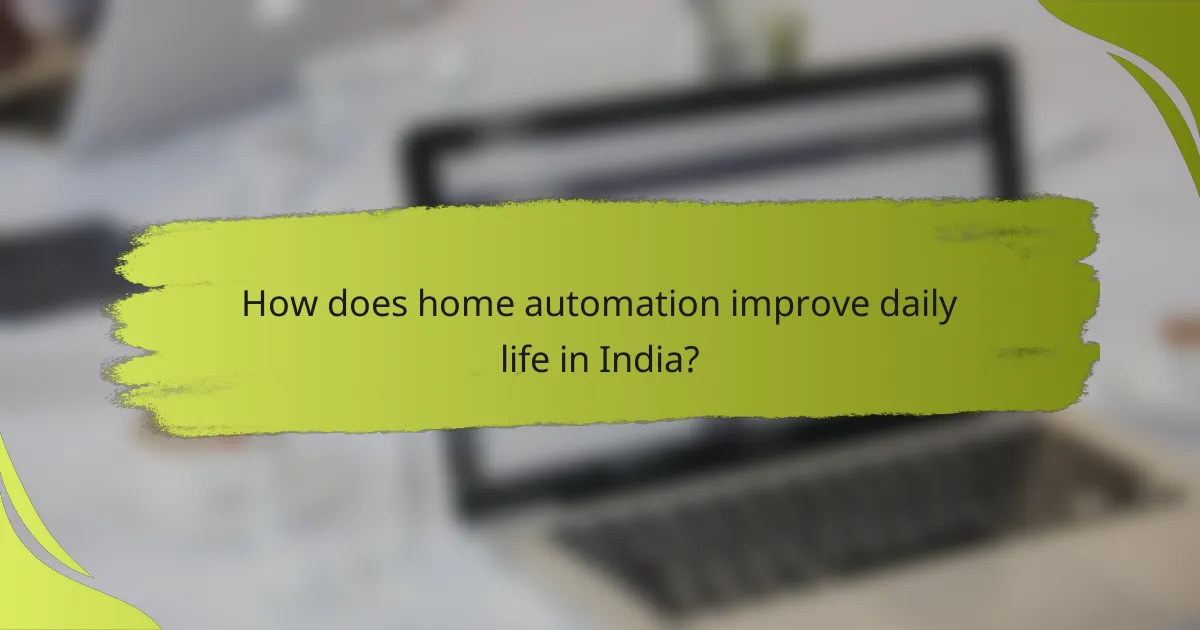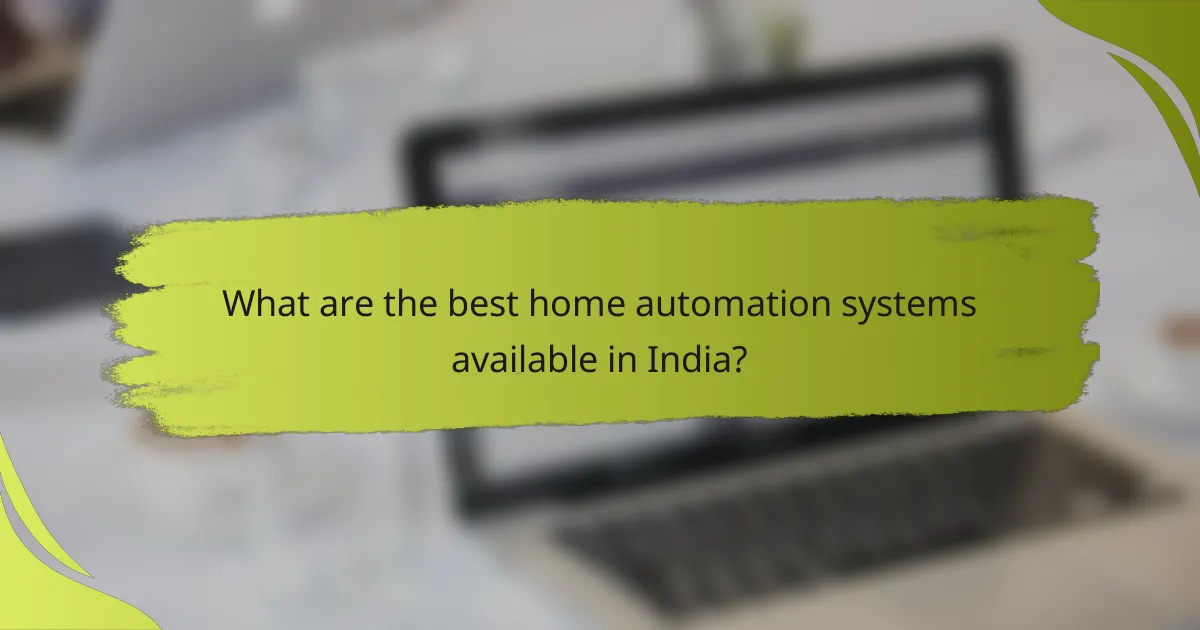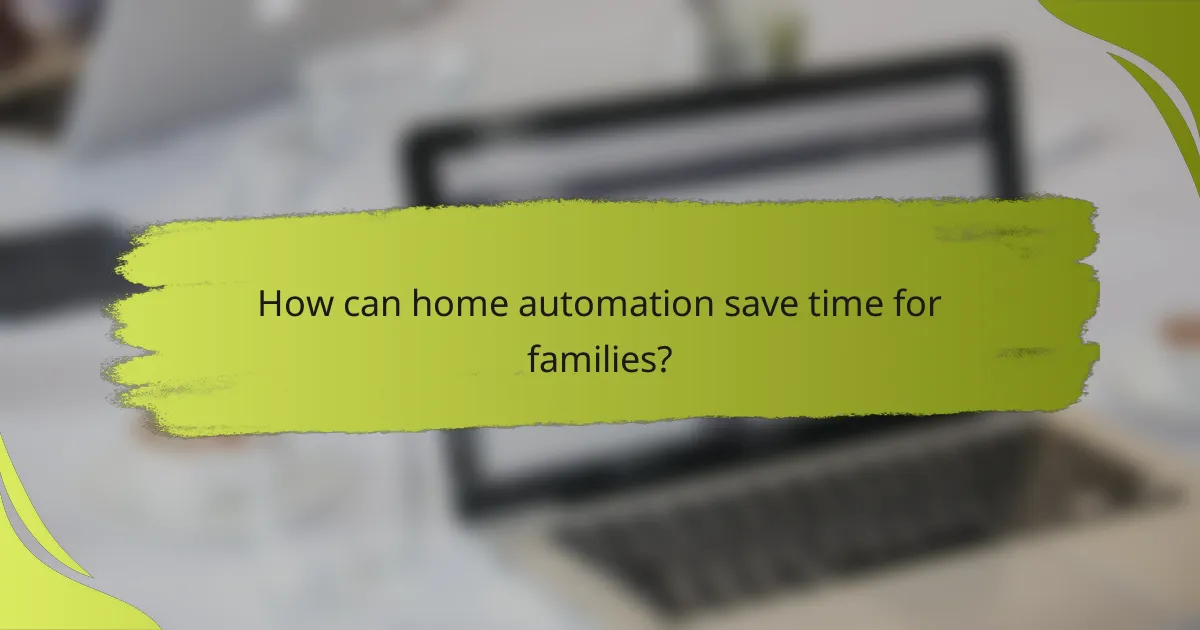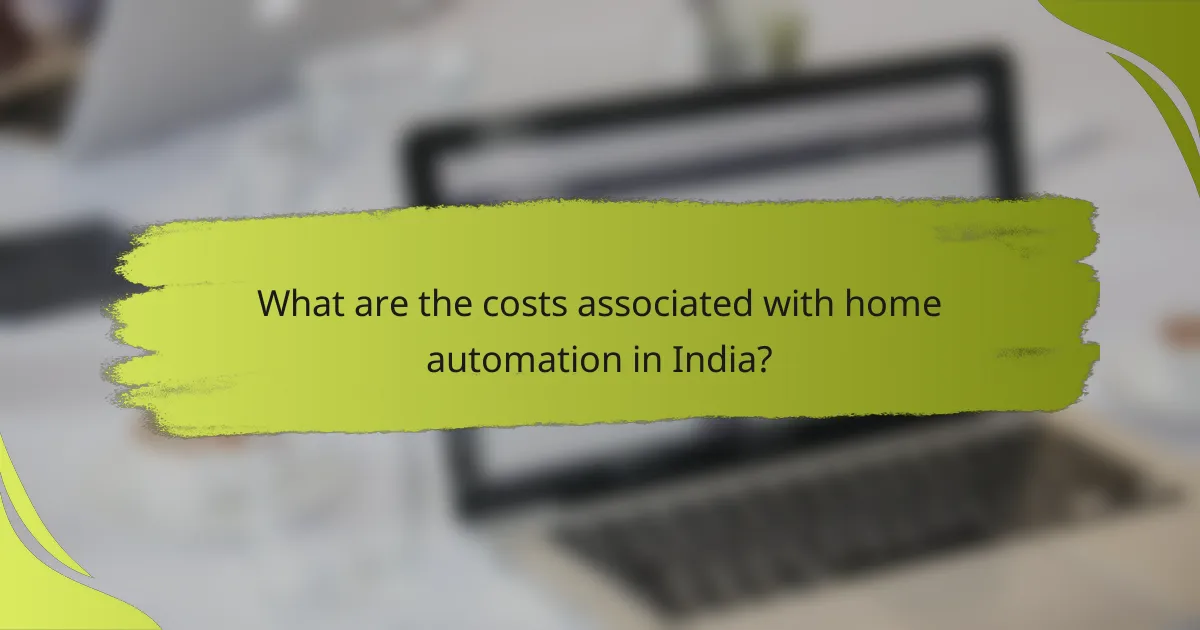Home automation is revolutionizing daily life by offering families enhanced convenience, energy efficiency, and improved security. By integrating smart devices, households can streamline routines and save valuable time, creating a more comfortable and efficient living environment.

How does home automation improve daily life in India?
Home automation significantly enhances daily life in India by providing convenience, energy efficiency, security, and better management of household tasks. With the integration of smart devices, families can streamline their routines and save time while enjoying a more comfortable living environment.
Enhanced convenience
Home automation offers unparalleled convenience by allowing users to control various devices remotely through smartphones or voice commands. For instance, smart lighting systems can be programmed to turn on or off at specific times, eliminating the need to manually adjust switches.
Additionally, automated appliances like smart refrigerators can monitor food inventory and suggest recipes, making meal planning easier. This level of convenience is particularly beneficial for busy families, enabling them to focus on more important tasks.
Increased energy efficiency
Smart home devices contribute to increased energy efficiency by optimizing power usage. For example, smart thermostats can learn a household’s schedule and adjust heating or cooling accordingly, potentially reducing energy bills by a significant percentage.
Moreover, smart plugs can monitor energy consumption of connected devices, allowing families to identify and eliminate energy hogs. This not only saves money but also supports environmental sustainability, which is increasingly important in India.
Improved security
Home automation enhances security through smart surveillance systems and alarms that can be monitored remotely. Families can receive real-time alerts on their smartphones if unusual activity is detected, providing peace of mind when away from home.
Additionally, smart locks allow homeowners to control access to their property, enabling them to grant entry to guests or service providers without being physically present. This level of security is crucial in urban areas where safety concerns may be heightened.
Streamlined household management
Automated systems simplify household management by integrating various tasks into a single platform. For instance, smart home hubs can coordinate lighting, heating, and security systems, allowing for seamless operation with minimal effort.
Furthermore, scheduling features enable families to automate routine tasks, such as watering the garden or running the vacuum cleaner, freeing up valuable time for other activities. This streamlined approach helps maintain a well-organized home environment.

What are the best home automation systems available in India?
The best home automation systems in India include Google Nest, Amazon Echo, Philips Hue, and TP-Link Kasa. These systems enhance daily life by providing convenience and time savings through smart home integration and automation features.
Google Nest
Google Nest offers a range of smart home devices, including smart speakers, displays, and thermostats. These devices work seamlessly with Google Assistant, allowing users to control their home environment through voice commands or mobile apps.
Key features include smart lighting control, temperature regulation, and security monitoring. Users can set routines, such as turning off lights and adjusting the thermostat at bedtime, enhancing comfort and energy efficiency.
Amazon Echo
Amazon Echo devices are powered by Alexa, Amazon’s voice assistant, which enables users to manage various smart home devices effortlessly. The Echo line includes smart speakers and displays that can control lights, locks, and more.
With Alexa Skills, users can customize their Echo experience by adding functionalities like music streaming and home security alerts. Integration with a wide range of third-party devices makes it a versatile choice for home automation.
Philips Hue
Philips Hue specializes in smart lighting solutions that allow users to control their home lighting through an app or voice commands. The system offers a variety of bulbs and fixtures that can be customized for color and brightness.
Users can set schedules, create scenes for different moods, and even sync lights with music or movies for an immersive experience. Philips Hue is compatible with major smart home systems, making it easy to integrate into existing setups.
TP-Link Kasa
TP-Link Kasa provides a range of smart plugs, switches, and cameras that can be controlled via the Kasa app or voice commands. This system is known for its user-friendly setup and affordability, making it accessible for many households.
Key features include remote access to devices, scheduling, and energy monitoring. Kasa devices are compatible with both Google Assistant and Amazon Alexa, allowing for flexible integration into various smart home ecosystems.

How can home automation save time for families?
Home automation can significantly save time for families by streamlining daily tasks and reducing the need for manual intervention. By integrating smart devices, families can manage their routines more efficiently, allowing for more free time and less stress.
Automated routines
Automated routines allow families to set schedules for their smart devices, enabling them to perform tasks at specific times without manual input. For example, lights can turn on at sunset, and the thermostat can adjust temperatures before family members arrive home. This not only saves time but also enhances comfort and energy efficiency.
Consider creating routines for morning and evening activities, such as having coffee brewed automatically or the security system activated at bedtime. This consistency helps families stay organized and reduces the mental load of remembering daily tasks.
Remote control features
Remote control features enable families to manage devices from anywhere using smartphones or tablets. This capability is particularly useful for adjusting settings while away from home, such as turning on lights or checking security cameras. It provides peace of mind and convenience, especially for busy families.
Many smart home systems allow for voice commands through virtual assistants, making it even easier to control devices hands-free. Families should ensure their devices are compatible with their preferred control methods to maximize convenience.
Integration with calendars
Integrating home automation systems with family calendars can further enhance time savings. By syncing schedules, families can automate tasks based on their activities, such as preheating the oven when it’s time to cook dinner or adjusting lighting for movie nights.
Utilizing shared calendars allows all family members to stay informed about automated routines. This coordination helps prevent conflicts and ensures that everyone is on the same page regarding household activities, ultimately saving time and reducing misunderstandings.

What are the costs associated with home automation in India?
The costs associated with home automation in India can vary significantly based on the complexity of the system and the technology used. Generally, these costs can be categorized into initial setup costs, monthly subscription fees, and ongoing maintenance expenses.
Initial setup costs
Initial setup costs for home automation in India typically range from a few thousand to several lakhs of Indian Rupees, depending on the scale of the installation. Basic systems may start around INR 15,000, while more advanced setups with multiple devices and features can exceed INR 1,00,000.
When planning for initial costs, consider the types of devices you want to integrate, such as smart lighting, security cameras, or climate control systems. It’s also important to factor in installation fees, which can vary based on the complexity of the setup.
Monthly subscription fees
Monthly subscription fees for home automation services in India can range from INR 500 to INR 3,000, depending on the features and services included. Some systems offer basic functionalities without a subscription, while others require ongoing payments for cloud storage, remote access, or premium features.
Evaluate the necessity of these subscriptions based on your usage patterns. If you only need local control without remote access, you might avoid additional fees altogether.
Maintenance expenses
Maintenance expenses for home automation systems can vary, but budgeting around 5-10% of the initial setup cost annually is a good rule of thumb. This may include software updates, device replacements, or troubleshooting services.
Regular maintenance is crucial to ensure the longevity and efficiency of your system. Consider setting aside a small fund for unexpected repairs or upgrades to keep your home automation running smoothly.

What factors should be considered when choosing a home automation system?
When selecting a home automation system, consider compatibility with existing devices, user interface and ease of use, and scalability options. These factors will significantly influence the effectiveness and convenience of your automated home setup.
Compatibility with existing devices
Ensure the home automation system can seamlessly integrate with your current devices, such as smart thermostats, lights, and security cameras. Check for compatibility with popular standards like Z-Wave, Zigbee, or Wi-Fi to avoid investing in new hardware.
For example, if you already have smart bulbs from a specific brand, confirm that the automation system supports those products. Incompatibility can lead to frustration and increased costs.
User interface and ease of use
The user interface should be intuitive, allowing family members of all ages to operate it without difficulty. Look for systems that offer mobile apps, voice control, and web interfaces for convenient access.
Consider testing the interface before purchasing. A system that is difficult to navigate can lead to underutilization and dissatisfaction, negating the benefits of automation.
Scalability options
Choose a home automation system that can grow with your needs. Scalability allows you to add new devices and features over time without replacing the entire system.
Evaluate whether the system supports a wide range of devices and whether it can accommodate future technologies. This flexibility can save you money and hassle in the long run, ensuring your home remains up-to-date with advancements in automation.

How does home automation impact family safety?
Home automation significantly enhances family safety by integrating smart technologies that monitor and control various aspects of the home environment. These systems can provide real-time alerts, automate responses to emergencies, and create a more secure living space.
Smart Security Systems
Smart security systems include cameras, motion detectors, and alarms that can be monitored remotely via smartphones. They allow families to keep an eye on their property from anywhere, providing peace of mind. Many systems can send instant notifications if unusual activity is detected, enabling quick responses to potential threats.
When selecting a smart security system, consider features such as video quality, night vision, and integration with other smart devices. Look for systems that comply with local regulations and standards to ensure reliability and effectiveness.
Automated Lighting
Automated lighting can enhance safety by ensuring that homes are well-lit when needed. Smart bulbs can be programmed to turn on or off at specific times, deterring intruders and reducing the risk of accidents in dark areas. Additionally, some systems can simulate occupancy by randomly turning lights on and off.
To maximize safety, consider using motion-sensor lights in outdoor areas and hallways. This not only improves visibility but also conserves energy by ensuring lights are only on when necessary.
Emergency Alerts and Notifications
Home automation systems can be configured to send alerts for various emergencies, such as smoke detection or water leaks. These notifications can be sent directly to family members’ smartphones, ensuring immediate awareness and action. Some systems can even contact emergency services automatically.
When setting up emergency alerts, ensure that all family members are familiar with the system and know how to respond. Regularly test the alerts to confirm they are functioning correctly and update contact information as needed.
